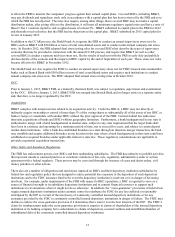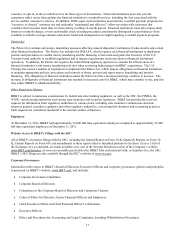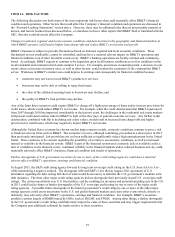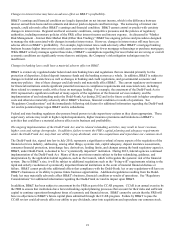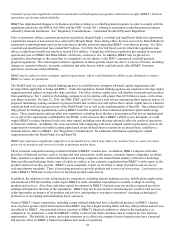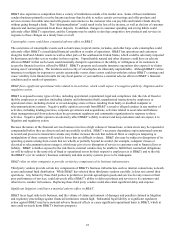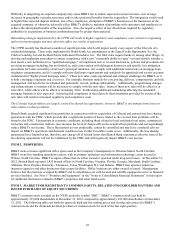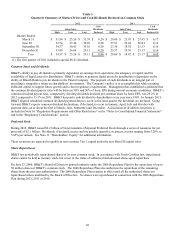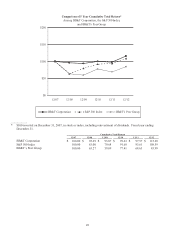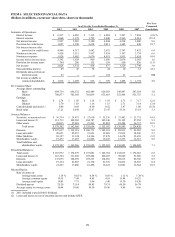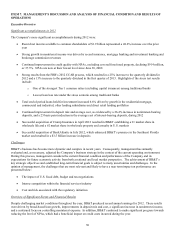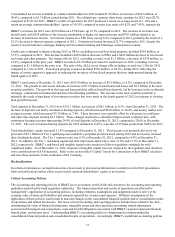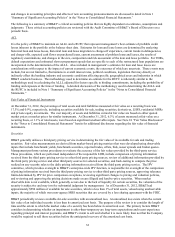BB&T 2012 Annual Report Download - page 44
Download and view the complete annual report
Please find page 44 of the 2012 BB&T annual report below. You can navigate through the pages in the report by either clicking on the pages listed below, or by using the keyword search tool below to find specific information within the annual report.22
Consumer protection regulations related to automated overdraft payment programs could adversely affect BB&T’s business
operations, net income and profitability.
BB&T has implemented changes to its business practices relating to overdraft payment programs in order to comply with the
regulations enacted by the FRB in July 2010 and the FDIC in July 2011 relating to automated overdraft payment programs
offered by financial institutions. See “Regulatory Considerations—Automated Overdraft Payment Regulation.”
Prior to enactment of these consumer protection regulations, Branch Bank’ s overdraft and insufficient funds fees represented
a significant amount of non-interest fees collected by Branch Bank. Since taking effect, the fees received by Branch Bank for
automated overdraft payment services have decreased, thereby adversely impacting BB&T’ s non-interest income. For 2010,
overdraft and insufficient fund fees totaled $427 million. For 2012, the first full fiscal year for which the regulations took
effect, overdraft and insufficient fund fees totaled $318 million. Complying with these regulations has resulted in increased
operational costs for BB&T and Branch Bank, which may continue to rise. In addition, BB&T may be placed at a
competitive disadvantage to the extent that its competitors are not subject to the FDIC’ s automated overdraft payment
program regulations. The actual impact of these regulations in future periods could vary due to a variety of factors, including
changes in customer behavior, economic conditions and other factors, which could adversely affect BB&T’ s business
operations, net income and profitability.
BB&T may be subject to more stringent capital requirements, which could diminish its ability to pay dividends or require
BB&T to reduce its operations.
The Dodd-Frank Act requires federal banking agencies to establish more stringent risk-based capital requirements and
leverage limits applicable to banks and BHCs. Under the legislation, federal banking agencies are required to develop capital
requirements that address systemically risky activities. The effect of these capital rules will disallow trust preferred securities
from qualifying as Tier 1 capital at the holding company level for entities with greater than $15 billion in assets, with a three-
year phase-in period. On June 12, 2012, the FRB, FDIC, and OCC issued a joint release announcing three separate notices of
proposed rulemaking seeking comment on proposed rules that would revise and replace their current capital rules in a manner
consistent both with relevant provisions of the Dodd-Frank Act as well as the implementation of Basel III. Once adopted and
fully phased in, banking organizations such as BB&T would be required to meet enhanced minimum capital and leverage
ratios. These requirements, and any other new regulations, including those that have been proposed but not yet implemented
as a result of the requirements established by the BCBS, could adversely affect BB&T’ s ability to pay dividends, or could
require BB&T to reduce business levels or to raise capital, including ways that may adversely affect its results of operations
or financial condition. In addition, the costs associated with complying with more stringent capital requirements, such as the
requirement to formulate and submit capital plans based on pre-defined stress scenarios on an annual basis, could have a
material adverse effect on BB&T. See “Regulatory Considerations” for additional information regarding the capital
requirements under the Dodd-Frank Act and Basel III.
BB&T may experience significant competition in its market area, which may reduce its customer base or cause it to lower
prices for its products and services in order to maintain market share.
There is intense competition among commercial banks in BB&T’ s market area. In addition, BB&T competes with other
providers of financial services, such as savings and loan associations, credit unions, consumer finance companies, securities
firms, insurance companies, commercial finance and leasing companies, the mutual funds industry, full-service brokerage
firms and discount brokerage firms, some of which are subject to less extensive regulations than BB&T is with respect to the
products and services they provide. BB&T’ s success depends, in part, on its ability to adapt its products and services to
evolving industry standards. There is increasing pressure to provide products and services at lower prices. Lower prices can
reduce BB&T’ s NIM and revenues from its fee-based products and services.
In addition, the adoption of new technologies by competitors, including internet banking services, mobile phone applications
and advanced ATM functionality could require BB&T to make substantial expenditures to modify or adapt its existing
products and services. Also, these and other capital investments in BB&T’ s business may not produce expected growth in
earnings anticipated at the time of the expenditure. BB&T may not be successful in introducing new products and services,
achieving market acceptance of its products and services, anticipating or reacting to consumers’ changing technological
preferences or developing and maintaining loyal customers.
Some of BB&T’ s larger competitors, including certain national banks that have a significant presence in BB&T’ s market
area, may have greater capital and resources than BB&T, may have higher lending limits and may offer products and services
not offered by BB&T. Any potential adverse reactions to BB&T’ s financial condition or status in the marketplace, as
compared to its competitors, could limit BB&T’ s ability to attract and retain customers and to compete for new business
opportunities. The inability to attract and retain customers or to effectively compete for new business may have a material
and adverse effect on BB&T’ s financial condition and results of operations.


